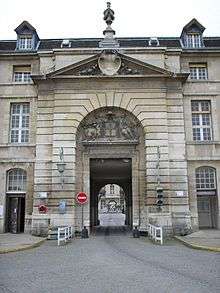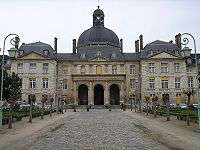Pitié-Salpêtrière Hospital
Pitié-Salpêtrière University Hospital (French: Hôpital universitaire la Pitié-Salpêtrière, [opital ynivɛʁsitɛʁ pitje salpɛtʁijɛʁ]) is a teaching hospital in the 13th arrondissement of Paris.[1] Part of the Assistance Publique – Hôpitaux de Paris and a teaching hospital of Sorbonne University, it is one of Europe's largest hospitals.[2] It is also France's largest hospital.
| Pitié-Salpêtrière Hospital | |
|---|---|
| AP-HP | |
 The Mazarin entrance to the Pitié-Salpêtrière Hospital | |

Location of Pitié-Salpêtrière Hospital within Paris | |
| Geography | |
| Location | 47-83 Boulevard de l'Hôpital, 75013 Paris, France |
| Organisation | |
| Care system | Public |
| Type | Teaching |
| Services | |
| Emergency department | Yes |
| Links | |
| Website | https://www.aphp.fr/ |
| Lists | Hospitals in France |
History
The Salpêtrière was originally a gunpowder factory (saltpetre being a constituent of gunpowder), but in 1656 at the direction of Louis XIV, it was converted into a hospice for the poor women of Paris as part of the General Hospital of Paris. It served as a prison for prostitutes, and a holding place for women who were learning disabled, mentally ill or epileptic, as well as poor; it was also notable for its population of rats and a bloated and unresponsive bureaucracy. Although the Pitié-Salpêtrière was much admired for the architectural ambitions of Libéral Bruant, it provided wretched living conditions for its inmates.[3] The building was enlarged in 1684. Engraving by L'Hopital de la Salpêtrière made around 1660 Pérelle. On the eve of the Revolution, it had become the world's largest hospital, with a capacity of 10,000 patients plus 300 prisoners. From La Salpêtrière they were paired with convicts and forcibly expatriated to New France.
During the September massacres of 1792, the Salpêtrière was stormed on the night of 3/4 September by a mob from the impoverished working-class district of the Faubourg Saint-Marcel, with the avowed intention of releasing the detained prisoners: 134 of the prostitutes were released; twenty-five madwomen were less fortunate and were dragged, some still in their chains, into the streets and murdered.[4]

At the very end of the 18th century, the early humanitarian reforms in the treatment of the mentally ill were initiated here by Philippe Pinel (1745–1826), friend of the Encyclopédistes. The iconic image of Pinel as the liberator of the insane was created in 1876 by Tony Robert-Fleury and Pinel's sculptural monument stands before the main entrance in Place Marie-Curie, Boulevard de L'Hôpital. Pinel was the chief physician of the Salpêtrière by 1794, in charge of a 200-bed infirmary[5] which housed a tiny proportion of the huge indigent female population. He was succeeded by his assistant Jean-Étienne Dominique Esquirol (1772–1840) who, from 1817, delivered the first systematic lectures on psychiatry in France and was the chief architect of the lunacy legislation of 30 June 1838. Esquirol was followed by Étienne Pariset; and from 1831 till 1867 the chef d'hospice was Jean-Pierre Falret (1794–1870) who contributed much to our understanding of bipolar disorder and folie à deux.
A regular visitor to the Salpêtrière from 1842 till his death more than thirty years later was Guillaume-Benjamin Duchenne de Boulogne (1806–1875). From humble provincial origins, a long line of seafarers from Boulogne, Duchenne became one of the outstanding medical scientists of the nineteenth century. Though he never held a senior appointment in the hospital, Duchenne nevertheless made meticulous observations on neurological patients, employing a wide range of innovative diagnostic techniques. Duchenne's clinical science stood at the junction of electricity, photography and psychology, as recorded in his much admired De l'électrisation localisée with its associated atlas Album de photographies pathologiques (1855, 1862). His name is commemorated in the myopathies which he described, as well as in his 1862 masterpiece, the Mécanisme de la physionomie humaine, much consulted by Charles Darwin in the preparation of his Expression of the Emotions in Man and Animals (1872).[6] Duchenne's last major work (published in 1867) was a study of the physiology of movement. He was never elected to the Academy of Sciences.
Later, when Jean-Martin Charcot (1825–1893) took over the department, the Salpêtrière became celebrated as a neuropsychiatric teaching centre, represented on canvas in 1887 by A Clinical Lesson at the Salpêtrière by André Brouillet. In his lectures and demonstrations, the leçons du mardi, Charcot systematised the neurological examination, did much to map out the territory of modern clinical neurology and, in a personal enthusiasm, explored its interface with psychological distress as represented in hysteria. Although Charcot insisted that hysteria could be a male disorder ("traumatic hysteria"), he is popularly remembered for his demonstrations with Louise Augustine Gleizes and Marie Wittman, known as the Queen of Hysterics.[7][8][9][10] Charcot had also absorbed much from Duchenne (to whom he often referred as "mon maître, Duchenne") and his teaching activities on the Salpêtrière's wards helped to elucidate the natural history of many diseases including neurosyphilis, epilepsy, and stroke.[11] In his discussion of paralysis agitans, Charcot drew attention to the 1817 description by James Parkinson, and suggested it be renamed Parkinson's disease. In 1882, with Charcot's encouragement, Albert Londe created a photographic department in the Salpêtriėre, producing, in collaboration with Georges Gilles de la Tourette, the Nouvelle Iconographie de la Salpêtrière of 1888.[12][13]
Students came from across the world to witness Charcot's clinical demonstrations: among them – in 1885 – was the 29-year old Sigmund Freud who translated Charcot's lectures into German and whose deconstruction of the lectures on hysteria formed the foundations of psychoanalysis. The first English translations of Charcot's Clinical Lectures (1877, 1881) were published by the Irish physician and statesman George Sigerson. Public health physician and advocate of breastfeeding Truby King travelled from New Zealand to witness Charcot, and reported his clinical demonstrations to be a life-changing experience. A rather negative portrait of Charcot's clinical style emerges in the 1929 autobiographical memoir – The Story of San Michele – by the Swedish physician Axel Munthe, whose early idolatry of Charcot gave way to a kind of obsessive antagonism.
The Hôpital de la Pitié, founded about 1612, was moved next to the Salpêtrière in 1911 and fused with it in 1964 to form the Groupe Hospitalier Pitié-Salpêtrière. The Pitié-Salpêtrière is now a general teaching hospital with departments focusing on most major medical specialities.
Numerous celebrities have been treated at the Salpêtrière, including Michael Schumacher,[14] Ronaldo,[14] Prince Rainier of Monaco,[15] Alain Delon, Gérard Depardieu, and Valérie Trierweiler.[16] Former president Jacques Chirac had a pacemaker fitted at the Salpêtrière in 2008.[17] Celebrities have also died at the Pitié-Salpêtrière, including the singer Josephine Baker in 1975, following a cerebral haemorrhage; philosopher Michel Foucault (from complications of AIDS) on 25 June 1984; Diana, Princess of Wales in 1997;[18] and French bicycle racer Laurent Fignon in 2010 (from the metastatic spread of lung cancer).
The Brain and Spine Institute has been located in the hospital since it was established in September 2010.
Buildings
Hospital Chapel
Chapelle de la Salpêtrière (Hospital Chapel), at n° 47 Boulevard de l'Hôpital is one of the masterpieces of Libéral Bruant, architect of Les Invalides. It was built around 1675, on the model of a Greek cross and has four central chapels each capable of holding a congregation of some 1,000 people. Its central octagonal cupola is illuminated by picture windows in circular arcs.
Philippe Pinel monument
In the place in front of the main entrance to the Hospital, there is a large bronze monument to Philippe Pinel, who was chief physician of the Hospice from 1795 to his death in 1826. The Salpêtrière was, at the time, like a large village, with seven thousand elderly indigent and ailing women, an entrenched bureaucracy, a teeming market and huge infirmaries. Pinel created an inoculation clinic in his service at the Salpêtrière in 1799 and the first vaccination in Paris was given there in April 1800.
Notable doctors
Through its history, the Pitié-Salpétrière hosted notable doctors, among others:
- Philippe Pinel (1745–1826);
- Jean-Étienne Esquirol (1772–1840);
- Étienne-Jean Georget (1795–1828);
- William A. F. Browne (1805–1885);
- Bénédict Morel (1809–1873);
- Duchenne de Boulogne (1806–1875), teacher of Charcot;
- Ernest-Charles Lasègue (1816–1883);
- Jean-Martin Charcot (1825–1893), founder of modern neurology;[20]
- Alfred Vulpian (1826–1893) Physician and neurologist;
- Jules Bernard Luys (1828–1897), neurologist;
- Paul Richer (1849–1933), anatomist, collaborator of Charcot;
- Sigmund Freud (1856–1939), Charcot's student in Paris and father of psychoanalysis;[21]
- Joseph Babinski (1857–1932), another Charcot's student;
- Georges Gilles de la Tourette (1857–1904), neurologist;
- Axel Munthe (1857–1940), Swedish psychiatrist, author;
- Pierre Janet (1859–1947), psychologist;
- Abel Ayerza (1861–1918), Argentinian cardiologist;
- Gérard Encausse (1865–1916), physician;
- Maria Montessori (1870–1952), pioneer in education;
- Jacques Lacan (1901–1981), psychoanalyst;
- Christian Cabrol (1925–2017), cardiac surgeon, performed Europe's first heart transplantation on 27 April 1968.
- Iradj Gandjbakhch (b. 1941), cardiac surgeon, performed Europe's first heart transplantation on 27 April 1968 along with Dr. Cabrol; fitted a pacemaker on former president Jacques Chirac in 2008.
References
- "Pitié-Salpêtrière." Assistance Publique – Hôpitaux de Paris. Retrieved on 21 October 2018. "47–83 boulevard de l'Hôpital 75013 Paris"
- "How to conduct European clinical trials from the Paris Region?" (PDF). BioTeam® Paris Region. February 2003. Archived from the original (PDF) on October 17, 2007. Retrieved 30 September 2013.
- González Velasco, Pedro. "La Salpêtrière Hospital before Charcot". Neurologia. 28: 52–6. doi:10.1016/j.nrl.2012.03.017. PMID 22704980.
- This episode is discussed in detail by Mary Bosworth, "Anatomy of a Massacre: Gender, Power, and Punishment in Revolutionary Paris" Violence Against Women, 7.10, (2001:1101–1121).
- Risse, Guenter (1999-04-15). Mending Bodies, Saving Souls: A History of Hospitals. p. 311. ISBN 0-19-505523-3.
- Duchenne (de Boulogne), G.-B. (1990) The mechanism of human facial expression, edited and translated by R. Andrew Cuthbertson, Cambridge University Press and Paris: Éditions de la Maison des Sciences de L'homme. Definitive edition of Duchenne's masterpiece.
- Hustvedt, Asti (2011) Medical Muses: Hysteria in Nineteenth-Century Paris London, Berlin etc.: Bloomsbury Publishing. A biographical reconstruction of Charcot's clinical science.
- Esther Inglis-Arkell (August 14, 2014). "Meet the "Queen of Hysterics" Who Was Freud's Early Muse". io9. Retrieved 2017-08-26.
- "BLANCHE – IMAGINARNA DŽUNGLA". Atelje Galerija. Archived from the original on 2017-08-27. Retrieved 2017-08-26.
- Entertainment (2014-06-14). "Medical history's mystery woman finds her voice". Smh.com.au. Retrieved 2017-08-26.
- Charcot, Jean-Martin (1991) Clinical Lectures on Diseases of the Nervous System edited and introduced by Ruth Harris. London and New York: Tavistock/Routledge Tavistock Classics in the History of Psychiatry.
- Didi-Huberman, Georges (1982) The Invention of Hysteria: Charcot and the Photographic Iconography of the Salpêtrière, translated (2003) by Alisa Hartz. Cambridge, Massachusetts and London, England: MIT Press. A scholarly art-historical reworking of Charcot's iconographic neurology.
- Gordon, Rae Beth (2009) Dances with Darwin: Vernacular Modernity in France 1875 - 1910 London: Ashgate Publishing. A scholarly survey of the interaction of Darwinism with Charcot's neurology and the popular café culture of the day.
- "Interview with Professor Gérard Saillant". Fia.com. Archived from the original on November 18, 2008. Retrieved 2011-12-21.
- "Prince Rainier health "worrying"". BBC News. 2005-03-25. Retrieved 2011-12-21.
- "A Survivor of the Painful Road to Hell and Back". The Guardian. Retrieved 2018-10-21.
- "Europe | France's Chirac gets pacemaker". BBC News. 2008-04-11. Retrieved 2011-12-21.
- Series of Real-Time Reports involving the tragic death of Diana, Princess of Wales Archived October 7, 2006, at the Wayback Machine
- N. Mclntyre, "The Medical Statues of Paris"
- Lamberty (2007). Understanding Somatization in the Practice of Clinical Neuropsychology. Minneapolis Oxford University. p. 5. ISBN 9780195328271.
- "Freud, Sigmund | Internet Encyclopedia of Philosophy". www.iep.utm.edu. Retrieved 2017-02-17.
External links
| Wikimedia Commons has media related to Hôpital de la Pitié-Salpêtrière. |
- Pitié-Salpêtrière Hospital (in French)
- History of La Salpêtrière
- Salpêtrière Hospital records, 1859–1942 (inclusive), 1900–1919 (bulk), HMS c30. Harvard Medical Library, Francis A. Countway Library of Medicine, Center for the History of Medicine, Harvard Medical School